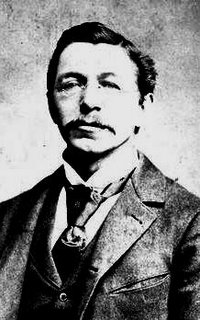Coxey and His Army

Unemployment agitator Jacob Coxey was born on this day in 1854 in Selinsgrove, Pennsylvania.
A scrap metal dealer and quarry owner, Jacob Coxey became a wealthy man selling crushed sandstone for use in the steel and glass industries. By the 1890s, Coxey was a gentleman-dilletante with an interest in thoroughbred race horses (which led to the dissolution of his first marriage; two years later he married his former maid), monetary theory, and ultimately, the Depression of 1893. He proposed two novel ideas for combating unemployment: (1) put the nation's unemployed to work building roads, and (2) pay for the roads and other job-creating construction projects by issuing non-interest-bearing bonds.
The fact that Coxey's silicate business might benefit from such a program should not be taken cynically. Coxey was an earnest crank who believed in grand plans and in doing good. His earnestness, in fact, caused him to fall prey to the influence of a fast-talking traveling medicine showman wearing a sombrero and a fur cape, one Carl Browne of California, who convinced Coxey that he was divinely fated to lead the meek to glory. Hearing about the marches of the unemployed in California, Coxey declared that he should "send a petition to Washington with boots on." Browne egged him on, getting the newly-styled "General Coxey" to spend a lot of money on a march of "Coxey's Army" to Washington.
They left Massillon on March 24, 1894, and the pageantry of the bizarre march, as the crew paraded through American cities and towns, was irresistible to the press. Coxey's march became the most extensively reported American event between the Civil and the Spanish-American Wars. On May 1, 1894, Coxey's scant hundred, joined perhaps by another 200, followed Coxey down Pennsylvania Avenue toward the Capitol, with Coxey's wife Henrietta and infant child Legal Tender riding in a carriage and Coxey's 17-year old daughter Mamie dressed as the goddess of freedom, to the cheers of nearly 30,000 spectators.
Coxey had been granted a parade permit, but was warned not to take the throng to the steps of the Capitol; but as the parade turned aside, Coxey and Browne jumped over a low wall and attempted to address the crowd from the Capitol grounds. The grand march of Coxey's Army ended with a whimper: Coxey and Browne were jailed for 20 days for walking on the Capitol lawn. Shortly afterward, Coxey broke his ties with Browne when he discovered that Browne had been courting Mamie behind his back. Browne and Mamie eloped the following year.
Coxey returned to Massillon and became a perennially unsuccessful office-seeker, running as a Democrat, Republican, Populist or Farmer-Laborite as the prevailing winds suggested. Surprisingly, he won election as mayor of Massilon in 1931 as a Republican. The following year, he ran for the Republican nomination for president and eventually accepted the nomination of the Farmer-Labor Party, launching a quixotic campaign in which he was largely ignored (he garnered just 7,309 votes). After losing his mayoral re-election bid in 1934, he launched one last, forgettable run at the presidency in 1936.
At age 90, on May 1, 1944, Coxey returned to Washington and was granted permission by Speaker Sam Rayburn and Vice President Henry Wallace to mount the Capitol steps and finish the speech he had intended to give 50 years earlier. His audience, largely curious federal employees, heard nothing radical -- for by that time, Coxey's once new ideas had actually formed the basis of some of Roosevelt's New Deal. He died on March 18, 1951 in Massillon, Ohio.
Categories: American-Politicians, Presidential-Campaigns





0 Comments:
Post a Comment
Subscribe to Post Comments [Atom]
<< Home